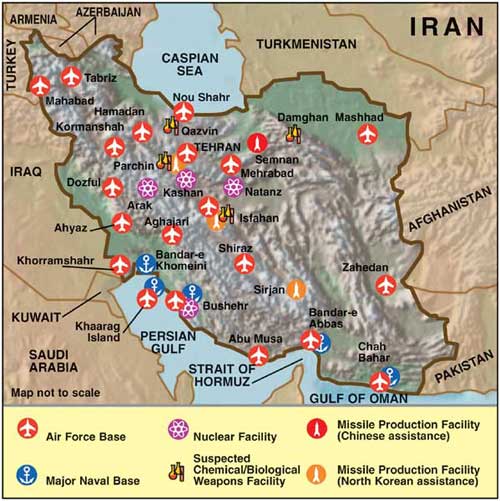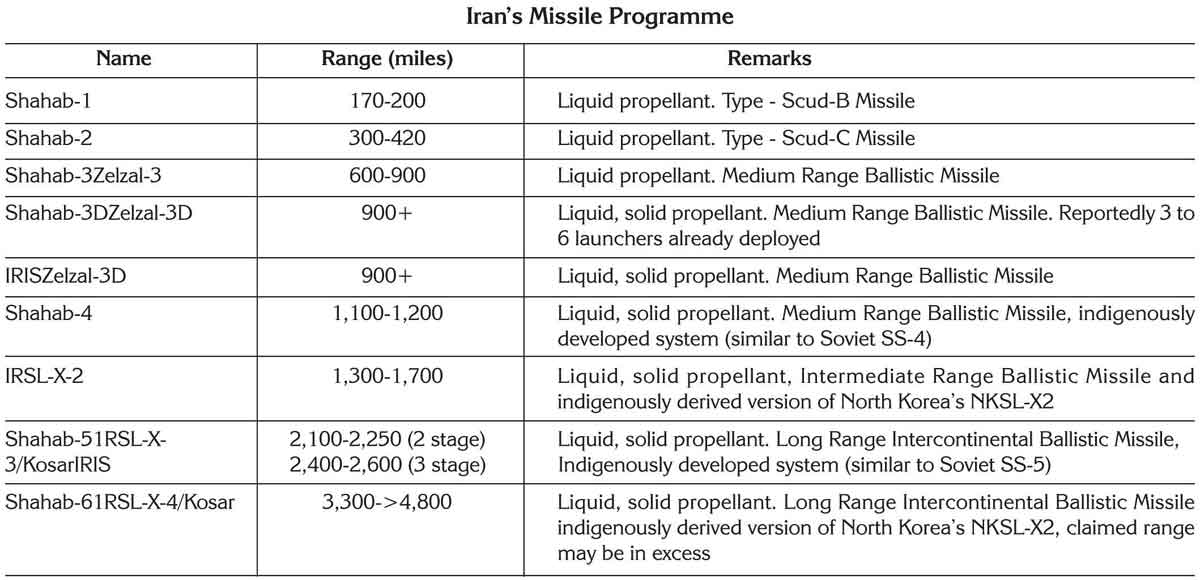Iran embarked on a comprehensive missile programme during the Iran-Iraq War. During the post war period, it has made a determined bid to enhance its missile arsenal and capabilities by reaching out to countries like North Korea and China. The missile capability is important to Iran as it finds it a cost effective method of neutralising the superiority or sophistication of the conventional arms of its adversaries. It has been making unrelenting efforts in developing both surface-to-surface and anti-ship missiles. It probably began with the acquisition of Scud missiles and missile production facilities acquired from North Korea and China. In the late ‘90s, Iran reportedly acquired Nodong-I (600 miles range) from North Korea and Silkworm missiles from China.
Iran’s missile programme is currently in a fairly advanced stage. It is believed to posses 250 to 300 Shahab-1 missiles (range 170 – 200 miles) and 200 to 450 Shahab-2 missiles (range 300 – 420 miles). These missiles are basically a copy of Scud-B and Scud-C respectively. Iran has been resorting to reverse engineering on missiles acquired from North Korea and China to develop its own indigenous capabilities. The presence of North Korean and Chinese experts in Iran for providing assistance in the missile programme is a well-publicised affair.
Nuclear Weapon Programme
The Shah had initiated Iran’s nuclear programme. He had planned to build 20 nuclear power reactors. Iran had ratified the Nuclear Non proliferation Treaty in 1970. Two power reactors still under construction in Bushehr were bombed by Iraq during the Iran-Iraq War. Even during the War there were some reports to suggest that Iran was pursuing a covert nuclear weapons programme. Some observers believed that following the end of the War, Tehran redoubled its efforts to develop nuclear weapons. The main problem that Iran faced was its inability to produce weapon-grade material. It allegedly tried to overcome this problem by attempting to smuggle fissile material from other countries like Russia and the Central Asian Republics. There were also allegations that in 1991, Iran clandestinely acquired two 40-kiloton warheads from Kazakhstan after the breakup of the Soviet Union.
Though Iran has ostensibly complied with the directives and inspections of the International Atomic Energy Agency (IAEA), some serious inconsistencies have caused concern to the IAEA. Iran’s efforts are focused both on Uranium enrichment and a parallel Plutonium effort. It claims that it is trying to establish a complete nuclear cycle to support a civilian energy programme, but there are apprehensions that the same fuel cycle would be applicable to a nuclear weapons development programme.
The National Council of Resistance to Iran in Washington revealed in August 2002 that Iran possessed two major nuclear facilities at Natanz (100 miles north of Isfahan) and Arak (150 miles south of Tehran). These two sites allegedly are used to produce enriched Uranium or Plutonium, the fissile material needed for nuclear weapons. The IAEA team in February 2003, detected that Iran had introduced some Uranium hexafluoride in the gas centrifuges, which was a breach of the Non Proliferation Treaty (NPT). Iran insists that its centrifuge enrichment programme is completely indigenous and it may have unwittingly acquired previously contaminated centrifuge components from foreign sources. The other issue that has aroused suspicion is Iran’s Uranium mining activities at Isfahan and Kashan. It is intriguing to some experts that since Russia had agreed to supply Uranium fuel for the Bushehr Reactor, there is actually no requirement for additional Uranium from domestic or other sources. Another remark from President Khatami that Iran proposed to reprocess spent fuel from the Bushehr Reactor was in clear violation of its agreement with Russia, whereby it was agreed that Iran would return the spent fuel.
In June 2003, the Iranian authorities intimated the IAEA regarding a heavy water production plant currently under construction, and a nuclear research and power reactor planned for construction in 2004 at Arak.
 Importantly, on 21 November 2003, Iran accepted the IAEA proposal to sign the additional protocol to the Nuclear Non Proliferation Treaty that allows for unannounced inspection of its nuclear facilities. Despite assurances to the IAEA and the EU-3 i.e. UK, France and Germany, Iran continued with its enrichment programme. Iran also maintains that an active Uranium enrichment programme is vital to the nation’s long-term plan for nuclear power development. The plan envisages construction of eight nuclear reactors, the first of which is likely to be operational in the near future. The US maintains that the enrichment programme is a subterfuge for a nuclear weapons programme. In February 2004, the IAEA came across designs for an advanced P-II centrifuge that was not mentioned earlier by Iran while declaring its nuclear programme. There are allegations that the design of the gas centrifuge bears complete resemblance to one that was clandestinely supplied by Pakistan to Libya. Certain quarters also allege that Pakistan had also supplied to Libya a nuclear warhead design. Moreover, the US continues to be disconcerted with Russian assistance to Iran’s nuclear plant at Bushehr. Lately, Iran has adopted a more strident posturing with regard to the IAEA and even the EU-3 on the plea that it cannot be prevented from a logical pursuit of a technology for peaceful benefits.
Importantly, on 21 November 2003, Iran accepted the IAEA proposal to sign the additional protocol to the Nuclear Non Proliferation Treaty that allows for unannounced inspection of its nuclear facilities. Despite assurances to the IAEA and the EU-3 i.e. UK, France and Germany, Iran continued with its enrichment programme. Iran also maintains that an active Uranium enrichment programme is vital to the nation’s long-term plan for nuclear power development. The plan envisages construction of eight nuclear reactors, the first of which is likely to be operational in the near future. The US maintains that the enrichment programme is a subterfuge for a nuclear weapons programme. In February 2004, the IAEA came across designs for an advanced P-II centrifuge that was not mentioned earlier by Iran while declaring its nuclear programme. There are allegations that the design of the gas centrifuge bears complete resemblance to one that was clandestinely supplied by Pakistan to Libya. Certain quarters also allege that Pakistan had also supplied to Libya a nuclear warhead design. Moreover, the US continues to be disconcerted with Russian assistance to Iran’s nuclear plant at Bushehr. Lately, Iran has adopted a more strident posturing with regard to the IAEA and even the EU-3 on the plea that it cannot be prevented from a logical pursuit of a technology for peaceful benefits.
Chemical & Biological Weapons
The US and some other western sources have concluded that despite being a signatory to the Chemical Weapons Convention, Iran persists with its chemical weapons programme. In their opinion, Iran has the capability to produce blister and choke agents and is now working on nerve agents. They allege that China is assisting Iran in this endeavour. According to them, Iran’s chemical agent production capability is over 1,000 tonnes a year and the main production centres are located at Damghan, Isfahan, Parchin and Qazvin. Fears are also expressed that Iran may well become a source of chemical agents / weapons to other countries given its delinquent past wherein it allegedly sold chemical weapons to Libya in 1987.
During the Iran-Iraq War, there were unconfirmed moves by Iran to acquire biological warfare capabilities. Some western observers aver that Iran is seriously engaged in the development of biological agents at a facility near Damghan. Some experts have also concluded that Iran already possesses a modest biological warfare capability. However, all these inputs and reports have not been substantiated and may well be exaggerated.





